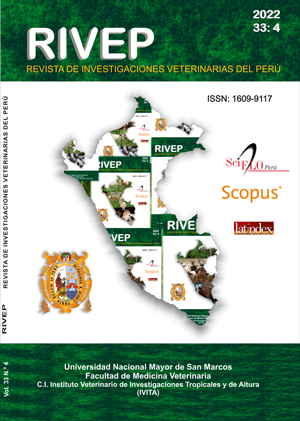Seminal characteristics of ovine under environmental conditions of Colombian Caribbean
DOI:
https://doi.org/10.15381/rivep.v33i4.21611Keywords:
andrology, ram, reproduction, semen, Colombian hair sheepAbstract
The aim of this study was to evaluate the seminal characteristics and the physical and functional conditions of native and introduced sheep breeds under the environmental conditions of the Colombian Caribbean. In total, 117 Santa Inés, Dorper, Katahdin and Ovinos de Pelo Colombiano (OPC) rams older than 11 months were evaluated for 14 months. The animals were from 18 farms of the departments of Córdoba, Sucre, Bolívar, Cesar and La Guajira. The physical-functional examinations of the males were carried out, as well as the macroscopic and microscopic characteristics of the semen. There were no differences (p>0.05) between breeds, departments and collection methods for the variables testicular volume, testicular length and width, scrotal circumference and testicular tone. In the humid Caribbean, mass motility was 76.36 ± 6.13% and the sperm concentration was 2707 ± 573x106 sperm/ml as compared to those found in the dry Caribbean (64.41 ± 5.45% and 962 ± 509.72 x106 sperm/ml, respectively). Semen collection method had a significant influence (p<0.05) on ejaculate volume, viability, vigour and sperm concentration. Seminal parameters were higher in the second and third trimester of the year and the relative humidity of the Caribbean had a significant effect on testicular volume (r=-0.23) and sperm abnormalities (r=0.29). It is concluded that the Santa Inés, Dorper, Katahdin and OPC sheep have satisfactory and viable characteristics for their reproduction in the Colombian Caribbean.
Downloads
Downloads
Published
Issue
Section
License
Copyright (c) 2022 Erly Luisana Carrascal-Triana, Diana Carolina Moya Romero, Natalia Herrera Perez, Jhon Jacobo Cañas Alvarez

This work is licensed under a Creative Commons Attribution 4.0 International License.
AUTHORS RETAIN THEIR RIGHTS:
a. Authors retain their trade mark rights and patent, and also on any process or procedure described in the article.
b. Authors retain their right to share, copy, distribute, perform and publicly communicate their article (eg, to place their article in an institutional repository or publish it in a book), with an acknowledgment of its initial publication in the Revista de Investigaciones Veterinarias del Perú (RIVEP).
c. Authors retain theirs right to make a subsequent publication of their work, to use the article or any part thereof (eg a compilation of his papers, lecture notes, thesis, or a book), always indicating the source of publication (the originator of the work, journal, volume, number and date).



